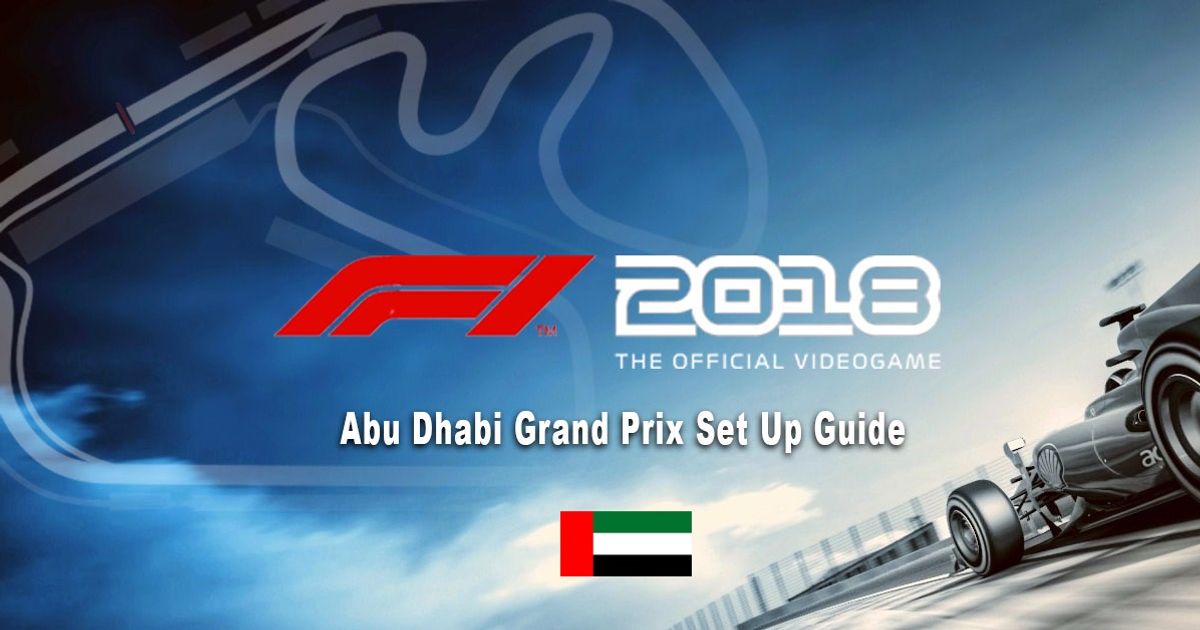The Abu Dhabi Grand Prix came onto the Formula 1 calendar in 2009 and is now well established as the season finale. The spectacle of F1 cars racing as the sun sets is wonderful, and the circuit isn't too bad either. The Yas Marina Circuit is a flowing ribbon of tarmac that features two long straights, smooth chicanes, and a tight final sector. Overtaking is tough, but there are two spots at the end of each straight to make a move. The circuit demands good top speed, but you also need a responsive car that can stick to the road around the 21 demanding corners.
Aerodynamics
The aerodynamics part of the setup establishes the wing angles for your car and the amount of downforce you can generate during the lap. We have gone with a 4 front wing, this reduces drag down the big straights allowing you to hit higher speeds, but still provides enough downforce to get the car into corners. The 6 rear wing keeps the car grounded during fast cornering, especially useful for the turn 15/16 part of the lap when we really throw the car around at high speed.
If you are using a lesser car in career mode, then you may need to add some more front wing in order to keep the car flowing smoothly through the twisty sections.
Transmission
The transmission part of the setup is all about how you get the power down through the rear tyres and into the tarmac. A fully locked differential forces the rear tyres to rotate at the same rate, increasing traction at the cost of tyre wear, while an unlocked one allows for more free rotation between the tyres. With so many corners you'd want to have a locked differential, but all that does is quickly burn up your rear tyres, resulting in a loss of grip very quickly during a race. As a result, we have settled on a 78 percent on-throttle differential, giving us a small boost in acceleration out of the corners without killing the rear tyres.
We have left the off-throttle differential alone at 75 percent, this allows a little more freedom to rotate when we are on the brakes, making turn-in a little easier.
Suspension Geometry
Suspension geometry describes how the tyres are aligned to the body of the car. Camber refers to the vertical alignment of the tyres. F1 cars are all set with negative camber, meaning the top of the tyre is closer to the body than the bottom. This aids with cornering grip, but reduces straight line speed and stability. While adding more camber will help us around the corners, the impact will be negative overall. As a result, we have removed some camber to gain more straight line speed into the major overtaking points and save the tyres a little.
Toe describes the horizontal alignment, with front tyres set to toe out, meaning the leading edge is further away than the back edge, and the rear tyres have toe in with the leading edge closer to the body of the car. Toe out improves responsiveness, and toe in improves straight line stability. Both are important but adding more will increase tyre wear, so we have left it alone at a 10-35 setting.
Suspension
Suspension settings are all about how your car handles. Stiffer suspension makes for a more responsive but a less compliant car. We have set the suspension at a very stiff 9-5 setting. This prevents forward weight roll during braking and keeps it at the rear for acceleration and creates a little oversteer to help get the nose into corners.
The anti-roll bars are stiffened slightly to help the car change direction at speed. We don't need to do that too often around Yas Marina, which is nice, so we don't have to bring the anti-roll bars up too far and punish the tyres.
Ride height is set to 4-4, nice and low thanks to the forgiving kerbs and smooth track surface. If you are struggling on turn-in then a good way to solve that problem is to create a rake by lowering the front ride height relative to the rear.
Brakes
The brakes section of the setup is important around Abu Dhabi. The two long, DRS-zone, straights lead to the only overtaking points of the lap, and getting the car stopped is vital to making a pass or defending against a faster car. Increasing brake pressure reduces stopping distance, but it also increases the chances of locking up and ruining your tyres. An 83 percent setting gives you the stopping power you need while not overly risking a lock up.
The brake bias is set to 54 percent. This is a rather severe rearward setting and increases oversteer to get the car into all of the corners.
Tyres
Tyre pressures are a balance between responsiveness, traction, rolling resistance, and wear. We haven't touched the front tyre pressures, because while increasing the pressure will improve cornering responsiveness, it will also increase wear which is already marginal.
We have increased the rear tyre pressure though. This helps get the back end through corners and reduces their rolling resistance at high speeds. It does lower traction out of corners, but that is ok as we get to top speed more reliably.
Weight Distribution
Weight ballast is set to 7. This is to move more weight over the rear tyres and help with traction. It also allows the front end to be lighter and more responsive to steering angle.
So there is our setup for Abu Dhabi. It is very fast in one lap, but can be tough on tyres and will require either an aggressive two-stop strategy or a carefully driven one-stop when driving a 50 percent race distance or more, however for online short races or time trials this is perfect. See you on the timesheets!
Explore new topics and discover content that's right for you!
F1




